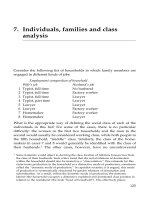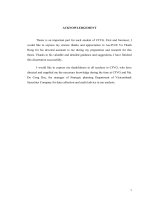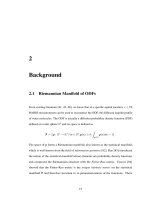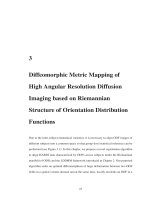lecture 11 dietary fiber and vitamin analysis
Bạn đang xem bản rút gọn của tài liệu. Xem và tải ngay bản đầy đủ của tài liệu tại đây (94.12 KB, 3 trang )
1
Dietary fiber and Vitamin
analysis
Pham Van Hung, PhD
Dietary fiber
• Dietary fiber is essentially the sum of the
nondigestible components of a foodstuff or food
product.
• Most, but not all, dietary fiber is plant cell-wall
material (cellulose, hemicelluloses, lignin) and thus
is composed primarily of polysaccharide molecules.
• Insoluble dietary fiber: cellulose, lignin,
hemicelluloses entrapped in a lignocellulosic matrix,
and resistant starch.
• Soluble dietary fiber: Hemicelluloses not
entrapped in a lignocellulosic matrix, much of the
native pectin, and the majority of hydrocolloids/food
gums.
Dietary fiber analysis
• Dietary fiber is often determined
gravimetrically. In such a procedure, digestible
carbohydrates, lipids, and proteins are
selectively solubilized by chemicals or removed
by enzyme-catalyzed hydrolysis.
• Nonsolubilized and/or nondigested materials are
collected by filtration, and the fiber residue is
recovered, dried, and weighed.
Dietary fiber analysis
• Starches and proteins are removed by
enzymes
• Lipids are removed easily from the
sample with organic solvents.
• Protein and minerals that are not emoved
from the sample during the solubilization
steps should be corrected for by Kjeldahl
nitrogen analysis and by ashing portions of
the fiber residue.
2
Dietary fiber analysis
Vitamin
• Vitamins are defined as relatively low-
molecularweight compounds which humans
require small quantities for normal metabolism.
• Humans cannot synthesize most vitamins and
therefore need to obtain them from food and
supplements.
• Insufficient levels of vitamins result in deficiency
diseases.
• The IU is a unit of measurement for the amount
of a substance, based on measured biological
activity or effect.
Vitamin
• Fat-soluble vitamins
– A: Retinol or β-carotene
– D: Cholecalciferol or Ergocalciferol
– K: Phylloquinone
– E: Tocopherol
• Water-soluble vitamins
– B complex: Thiamin (B1), Riboflavin (B2), Pyridoxine
(B6), Folic acid (B9), Cyanocobalamin (B12)
– C: ascorbic acid
Vitamin analysis
• Extraction Methods
– Ascorbic acid: Cold extraction with metaphosphoric
acid/acetic acid.
– Vitamin B1 and B2: Boiling or autoclaving in acid plus
enzyme treatment.
– Niacin: Autoclaving in acid (noncereal products) or
alkali (cereal products).
– Folate: Enzyme extraction with α-amylase, protease
and γ-glutamyl hydrolase(conjugase).
– Vitamins A, E, or D: Organic solvent extraction,
saponification, and re-extraction with organic
solvents. For unstable vitamins such as these,
antioxidants are routinely added to inhibit oxidation.
3
Vitamin analysis
• Bioassay Methods:
– vitamins B12 and D.
• Microbiological Assays:
– water-soluble vitamins.
– The growth of a certain microorganism in an extract of
a vitamin-containing sample is compared against the
growth of this microorganism in the presence of
known quantities of that vitamin.
• Chemical Methods
Vitamin analysis
• Vitamin A: The test sample is saponified with ethanolic
KOH, vitamin A (retinol) is extracted into organic solvent
and then concentrated. Vitamin A isomers – all-trans-
retinol and 13-cis-retinol – levels are determined by HPLC
on a silica column.
• Vitamin E: The sample is saponified under reflux,
extracted with hexane, and injected onto a normal phase
HPLC column connected to a fluorescence detector.
• Vitamin C: L-ascorbic acid is oxidized to L-
dehydroascorbic acid by the oxidation–reduction indicator
dye, 2,6-dichloroindophenol. At the endpoint, excess
unreduced dye appears rosepink in acid solution.
• Thiamin (B1): Following extraction, enzymatic hydrolysis
of thiamin’s phosphate esters and chromatographic
cleanup.
• Riboflavin (B2): Following extraction, cleanup, and
compensation for the presence of interfering substances,
riboflavin is determined fluorometrically.
The end!









